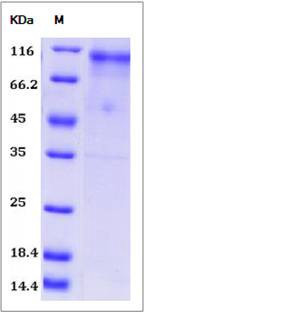Human / Rhesus HER4 / ErbB4 Protein (His Tag)
ALS19,HER4,p180erbB4
- 100ug (NPP3846) Please inquiry
| Catalog Number | P10363-H08H |
|---|---|
| Organism Species | Human |
| Host | Human Cells |
| Synonyms | ALS19,HER4,p180erbB4 |
| Molecular Weight | The recombinant human ERBB4 comprises 635 amino acids and has a predicted molecular mass of 71.1 kDa. The apparent molecular mass of the protein is approximately 102 kDa in SDS-PAGE under reducing conditions. |
| predicted N | Gln 26 |
| SDS-PAGE |  |
| Purity | > 85 % as determined by SDS-PAGE |
| Protein Construction | A DNA sequence encoding the human ERBB4 (NP_005226.1) (Met1-Arg649) with a C-terminal polyhistidine tag was expressed. Human and Rhesus ERBB4 sequences are identical. |
| Bio-activity | Measured by its binding ability in a functional ELISA. Immobilized human ErbB4-His at 10 μg/ml (100 μl/well) can bind biotinylated human NRG1 (P11609-H01H2), The EC50 of biotinylated human NRG1 (P11609-H01H2) is 0.4-0.92 μg/ml. |
| Research Area | Cancer |Invasion microenvironment |Angiogenesis |Growth Factor & Receptor |Receptor Tyrosine Kinase (RTK) |
| Formulation | Lyophilized from sterile PBS, pH7.4. 1. Normally 5 % - 8 % trehalose and mannitol are added as protectants before lyophilization. Specific concentrations are included in the hardcopy of COA. |
| Background | ERBB4 is a single-pass type I membrane protein with multiple cysteine rich domains, a transmembrane domain, a tyrosine kinase domain, a phosphotidylinositol-3 kinase binding site and a PDZ domain binding motif. ERBB4 is expressed at highest levels in brain, heart, kidney, in addition to skeletal muscle, parathyroid, cerebellum, pituitary, spleen, testis and breast. And lower levels in thymus, lung, salivary gland, and pancreas. It specifically binds to and is activated by neuregulins, NRG-2, NRG-3, heparin-binding EGF-like growth factor, betacellulin and NTAK. ERBB4 also can be activated by other factors and induces a variety of cellular responses including mitogenesis and differentiation. ERBB4 regulates development of the heart, the central nervous system and the mammary gland, gene transcription, cell proliferation, differentiation, migration and apoptosis. It is required for normal cardiac muscle differentiation during embryonic development, and for postnatal cardiomyocyte proliferation. ERBB4 also play a role on the normal development of the embryonic central nervous system, especially for normal neural crest cell migration and normal axon guidance. It is required for mammary gland differentiation, induction of milk proteins and lactation. |
| Reference |
